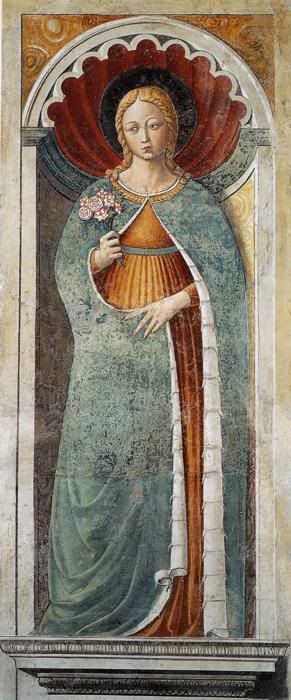Today, March 12, we remember Blessed Fina, also known as Seraphina (1238-1253), a young girl whose faith and endurance in pain and suffering is both miraculous and inspirational. Blessed Fina reminds us, especially during Lent, that our pain and sufferings are relieved when we offer them to Christ.
Born Fina dei Ciardi parents of nobility who had fallen on hard times, Fina grew up in the beautiful village of San Gimignano—an area recognized for the vain pride of its residents, as reflected in the magnificent homes and towers each family built in attempts to surpass their neighbors (many of which are still standing). From an early age, Fina lived like a hermitess in her own home. She refused to leave the house, except for Mass, so as to avoid the temptations of the world. Despite being quite beautiful, she dressed in rags, and lived a life of penance and mortification, including fasting, wearing a hair shirt, and periods of silence. Despite the family’s poverty, Fina world refuse food, instead requesting it be given to the poor, which her parents obliged.
When Fina was approximately ten years old, she was stricken with an aggressive disease, causing organ failure and paralysis. Rather than be placed in a bed, Fina chose to lay on the oak dining room table of the family, in view of the family crucifix, so that her suffering might be more like that of Christ. Despite terrible pain, and the inability any part of her body except her head, Fina prayed constantly, repeating the words, "It is not my wounds but thine, O Christ, that hurt me.”
Fina lay paralyzed for nearly six years, during which time her father passed away, followed by the untimely death of her mother. Pious legend tells us that the Devil himself was so angered by Fina’s piety and faith that he struck her mother down. Upon hearing of her death, Fina gazed into the rafters of the family home, seeing a large snake coiled there. When she called for help, none by she could see it, and she realized that Satan had killed her mother. With the assistance of her nurse, Fina made the sign of the cross, attesting to her faith despite this latest loss, and the snake disappeared from view.
With her parents gone, Fina was left alone and mostly neglected by her neighbors. So pitiful was her appearance, few would visit save a faithful friend and nurse. However, Fina was left for long periods of time each day alone, during which time rats and vermin would climb onto her, eating away the rotting flesh of her neglected body. She endured this pain and humiliation as she did all others, through prayer and faith.
Fina developed a strong devotion to Saint Gregory the Great, a saint known for his joyful suffering. She prayed for his assistance, an in the presence of her nurses, received a visitation from the great saint on March 4. Appearing to her, Saint Gregory stated, "Dear daughter, make your peace with Jesus Christ, as you did in the beginning, for on the Feast of St. Gregory, you will die, and God will reward you for your penances and sacrifices!" His feast, celebrated today, on March 12, was her last. Having received the sacraments of Reconciliation, Holy Eucharist, and Last Rites in the morning, Fina died peacefully in the afternoon at the age of 15.
At the exact time of her death, it is said that all the bells in town rang simultaneously, without anyone moving them to do so. Her wretched body was carried to the castle church, and when they separated her flesh from the rotting wood, it was found to be covered with white violets which exuded a beautiful perfume. These same flowers subsequently appeared throughout the town, growing on the walls of many buildings, and blooming every spring around her feast day. Locally, these flowers are called “Saint Fina’s Flowers” and said to grow nowhere else on earth.
Numerous miracles were reported following Fina’s death, including that of her faithful nurse who had suffered paralysis of her hand while nursing Fina. Additional miracles included the restoration of movement to the lame, and curing of terminal illnesses. Despite their ignoring of her while she lived, the entire town visited her body and attended her funeral Mass, dedicating the small chapel in her honor. She is considered, along with the Saint whose name the town bears, the patron of San Gimignano.
Blessed Fina demonstrated an unwavering confidence in the Lord—a heroic willingness to suffer, and through suffering join with Jesus in his pain. Through the most painful and humiliating circumstances, Fina’s faith never faltered, even when directly tempted by the Devil. We are called to take stock of our suffering, and in doing so, place it in perspective as compared to the graceful suffering of this young woman. The daily trials and struggles we endure are few as compared to Fina, and not even a grain of sand in the desert of Christ’s suffering for us. As we contemplate, we are encouraged to turn to Him, Our Savior, and offer our pain, echoing the words of Fina: “It is not my wounds but Thine, O Christ, that hurt me.”
Prayer Intentions: Grace in our suffering
Requested Intentions: The blessing of children (S); Safety of travelers (J); Improved family relationship with the Lord, using gifts for His glory (L); For the orphans of Saint Francis Xavier in India (Fr. B); For the health of a family member with Rett’s Disorder (C); For the restoration of hearing (L); For a restorative, faith-deepening Lent for all those who are struggling (L).
Special Intentions (Day 30 of 45-day Novena to Our Blessed Lady of Lourdes): The intentions of all those who read this blog, whether submitted or retained in the quiet of their hearts; Penance, Penance, Penance for sinners; For all those who are suffering.
Why pray the Rosary every day for a year?
Each time the Blessed Virgin has appeared-- whether it be to Saint Bernadette Soubirous at Lourdes; to Lucia, Jacinta, and Francisco at Fatima; or to Mariette Beco at Banneux-- she has asserted the importance, saving grace, and power of praying the Holy Rosary on a daily basis. Based upon her words, the Rosary is penance and conversion for sinners, a pathway to peace, an end to war, and a powerful act of faith in Jesus Christ. Pope Paul VI presented the Rosary as a powerful means to reach Christ "not merely with Mary but indeed, insofar as this is possible to us, in the same way as Mary, who is certainly the one who thought about Him more than anyone else has ever done."
To show us how this is done, perhaps no one has been more eloquent than the great Cardinal Newman, who wrote: "The great power of the Rosary consists in the fact that it translates the Creed into Prayer. Of course, the Creed is already in a certain sense a prayer and a great act of homage towards God, but the Rosary brings us to meditate again on the great truth of His life and death, and brings this truth close to our hearts. Even Christians, although they know God, usually fear rather than love Him. The strength of the Rosary lies in the particular manner in which it considers these mysteries, since all our thinking about Christ is intertwined with the thought of His Mother, in the relations between Mother and Son; the Holy Family is presented to us, the home in which God lived His infinite love."
As Mary said at Fatima, "Jesus wants to use you to make Me known and loved. He wishes to establish the devotion to My Immaculate Heart throughout the world. I promise salvation to whoever embraces it; these souls will be dear to God, like flowers put by Me to adorn his throne."

Subscribe to:
Post Comments (Atom)










0 comments:
Post a Comment
Thanks for leaving a comment. If you wish to submit a prayer request, however, please do so above, using the "Contact" tab.